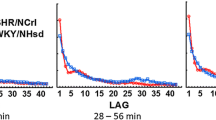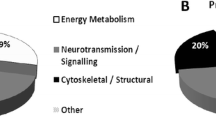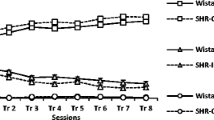The aim of the present work was to identify differences in movement activity in SHR and WKY rats and to assess the levels of expression of mRNA for NAP-22 and GAP-43 proteins in neurons in the parietal cortex and hippocampus. Movement activity in SHR and WKY rats (four animals in each group) was measured using a telemetric method over three days. Levels of expression of mRNA for NAP-22 and GAP-43 proteins in parietal cortex and hippocampal neurons in further groups of rats of the same strains (10 animals in each group) were measured in real time by PCR. Studies were carried out using animals from the Biological Collection of the Institute of Physiology, Russian Academy of Sciences. Movement activity in SHR rats was greater than that in WKY rats, though statistically these differences were significant only during the dark phase. Expression levels of mRNA for NAP-22 and GAP-43 proteins in SHR rats were lower than those in WKY rats in both the parietal cortex and the hippocampus. These results lead to the conclusion that the greater mobility in SHR rats reflects the typical hyperactivity of rats of this line, making them a suitable model for attention deficit hyperactivity disorder. Changes in the expression levels of mRNA for NAP-22 and GAP-43 proteins may be linked with behavioral impairments.
Similar content being viewed by others
References
T. Sagvolden and E. B. Johansen, “Rat models of ADHD,” in: Behavioral Neuroscience of Attention Deficit Hyperactivity Disorder and its Treatment, C. Stanford and R. Tannock (eds.), Springer, Berlin, Heidelberg (2012), pp. 301–315, https://doi.org/10.1007/7854_2011_126.
X. Fan, K. J. Bruno, and E. J. Hess, C. “Rodent models of ADHD,” in: Behavioral Neuroscience of Attention Deficit Hyperactivity Disorder and its Treatment, C. Stanford and R. Tannock (eds.), Springer, Berlin, Heidelberg (2012), pp. 273–300, https://doi.org/10.1007/7854_2011_121.
M. L. Tsai, A. Kozłowska, Y. S. Li, et al., “Social factors affect motor and anxiety behaviors in the animal model of attention-deficit hyperactivity disorders: A housing-style factor,” Psychiatry Res., 254, 290–300 (2017), https://doi.org/10.1016/j.psychres.2017.05.008.
C. T. Lai, C. Y. Chen, T. B. Kuo, et al., “Sympathetic hyperactivity, sleep fragmentation, and wake-related blood pressure surge during late-light sleep in spontaneously hypertensive rats,” Am. J. Hyperten., 29, No. 5, 590–597 (2015), https://doi.org/10.1093/ajh/hpv154.
Y. L. Hsieh and C. C. Yang, “Age-series characteristics of locomotor activities in spontaneously hypertensive rats: a comparison with the Wistar–Kyoto strain,” Physiol. Behav., 93, No. 4–5, 777–782 (2008), https://doi.org/10.1016/j.physbeh.2007.11.032.
N. N. Zavadenko, “Attention deficit hyperactivity disorder: advances in diagnosis and treatment,” Vestn. Severn. (Arktich.) Fed. Univ. Ser. Med.-Biol. Nauki, 1, 31–39 (2014).
R. H. Cox and N. J. Rusch, “New expression profiles of voltage-gated ion channels in arteries exposed to high blood pressure,” Microcirculation, 9, No. 4, 243–257 (2002), https://doi.org/10.1038/sj.mn.7800140.
T. Berg, “Altered β1-3-adrenoceptor influence on α2-adrenoceptor-mediated control of catecholamine release and vascular tension in hypertensive rats,” Front. Physiol., 6, 120 (2015), https://doi.org/10.3389/fphys.2015.00120.
J. S. Takahashi, “Transcriptional architecture of the mammalian circadian clock,” Nat. Rev. Genet., 18, No. 3, 164 (2017), https://doi.org/10.1038/nrg.2016.150.
W. Huang, K. M. Ramsey, B. Marcheva, and J. Bass, “Circadian rhythms, sleep, and metabolism,” J. Clin. Invest., 121, No. 6, 2133–2141 (2011), https://doi.org/10.1172/JCI46043.
M. I. Mosevitsky, “Nerve ending ‘signal’ proteins GAP-43, MARCKS, and BASP1,” Int. Rev. Cytol., 245, 245–325 (2005), https://doi.org/10.1016/S0074-7696(05)45007-X.
N. Z. Klyueva, E. D. Rudenko, A. S. Aldekeeva, et al., “Effects of salt loading on the level of metabolism of NAP-22 protein – a major substrate of protein kinase C – in the hippocampus and parietal cortex of rats with spontaneous hypertension,” Arter. Hypertens., 23, No. 4, 325–331 (2017), https://doi.org/10.18705/1607-419X-2017-23-4-325-331.
R. Enoki, D. Ono, S. Kuroda, et al., “Dual origins of the intracellular circadian calcium rhythm in the suprachiasmatic nucleus,” Sci. Rep., 7, 41733 (2017), https://doi.org/10.1038/srep41733(2017).
E. B. Arushanyan and A. V. Popov, “Current concepts of the role of the suprachiasmatic nuclei of the hypothalamus in the organization of diurnal periodicity of physiological functions,” Usp. Fiziol. Nauk., 42, No. 4, 39–58 (2011).
A. Natsubori, K. Honma, and S. Honma, “Dual regulation of clock gene Per2 expression in discrete brain areas by the circadian pacemaker and methamphetamine-induced oscillator in rats,” Eur. J. Neurosci., 39, No. 2, 229–240 (2014), https://doi.org/10.1111/ejn.12400.
T. D. Schmittgen and K. J. Livak, “Analyzing real-time PCR data by the comparative C (T) method,” Nat. Protoc., 3, No. 6, 1101–1108 (2008), https://doi.org/10.1038/nprot.2008.73.
R. H. Cox and S. Fromme, “Expression of calcium channel subunit variants in small mesenteric arteries of WKY and SHR,” Am. J. Hypertens., 28, No. 10, 1229–1239 (2015), https://doi.org/10.1093/ajh/hpv024.
S. K. Churina, N. Z. Klyueva, O. S. Antonova, et al., “Genetically determined mechanisms of arterial hypertension related to dietary calcium deficiency (parathyroid hypertensive factor),” Arter. Gipertenz., 20, No. 5, 343–348 (2014), https://doi.org/10.18705/1607-419X-2014-20-5-342-348.
E. Kropotova, B. Klementiev, and M. Mosevitsky, “BASP1 and its N-end fragments (BNEMFs) dynamics in rat brain during development,” Neurochem. Res., 38, No. 6, 1278–1284 (2013), https://doi.org/10.1007/s11064-013-1035-y.
R. Zhou, Y. Bai, R. Yang, et al., “Abnormal synaptic plasticity in basolateral amygdala may account for hyperactivity and attention-deficit in male rat exposed perinatally to low-dose bisphenol-A,” Neuropharmacology, 60, No. 5, 789–798 (2011), https://doi.org/10.1016/j.neuropharm.2011.01.031.
Author information
Authors and Affiliations
Corresponding author
Additional information
Translated from Rossiiskii Fiziologicheskii Zhurnal imeni I. M. Sechenova, Vol. 106, No. 5, pp. 654–662, May, 2020.
Rights and permissions
About this article
Cite this article
Aldekeeva, A.S., Reznik, S.Y., Kraynova, Y.S. et al. Motor Activity and Levels of Expression of mRNA for the Proteins NAP-22 and GAP-43 in Spontaneously Hypertensive Rats. Neurosci Behav Physi 51, 265–269 (2021). https://doi.org/10.1007/s11055-021-01065-7
Received:
Revised:
Accepted:
Published:
Issue Date:
DOI: https://doi.org/10.1007/s11055-021-01065-7




